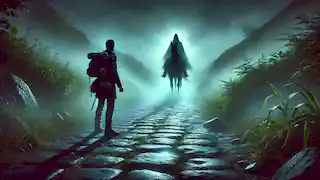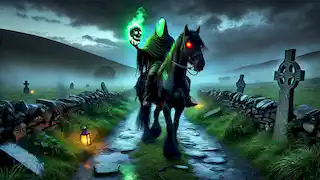{{{_intro}}} In the windswept hills of Ireland, folklore and myth intertwine in a world teeming with spirits, fae, and legendary beings. One figure, however, stands apart from all others in its eerie and terrifying nature: the Dullahan. Often depicted as a headless rider, the Dullahan is not a creature to be trifled with. Its presence on the roads and countryside of Ireland signals doom, its black horse pounding the earth as it pursues the souls it has come to collect. Its story, shrouded in mystery, reaches deep into the collective imagination of the Irish people, evoking fear and reverence in equal measure. The Dullahan is one of the most feared creatures in Irish mythology, sometimes known as the "Headless Horseman." Unlike the more romanticized versions of headless riders that appear in literature, the Dullahan’s legend is much older and infinitely more sinister. The legend speaks of a rider who is always seen with his decapitated head in hand, his eyes darting wildly, able to see all that lies before him despite his gruesome condition. It is said that the head emits a faint glow, allowing the Dullahan to see at night as he rides through the Irish countryside. The Dullahan's purpose is singular and terrifying: to claim the souls of those whose time on earth has come to an end. His horse, jet black with burning eyes, strikes fear into the hearts of those who hear it approaching, hooves striking like thunder across the cobbled roads or misty moors. Where the Dullahan rides, death soon follows. But what makes this spectral figure so feared is the belief that his appearance is an omen of unavoidable death. Once the Dullahan has spoken your name, your fate is sealed. No mortal power can delay or divert his grim mission, and no door can keep him out. His presence is both a judgment and a sentence. The Dullahan is often associated with the ancient Celtic god Crom Dubh, a dark deity once worshipped in pre-Christian Ireland. Crom Dubh was a fertility god, but his cult practices included human sacrifice, particularly the offering of heads to ensure a bountiful harvest. When Christianity spread across Ireland, these pagan practices were outlawed, and the old gods were demonized. The Dullahan, with his decapitated head and his role as a harbinger of death, may be a lingering remnant of this ancient religious tradition. The Dullahan’s head, which he carries under his arm, is grotesque and pale, with a macabre grin stretching from ear to ear. His flesh is said to have the texture of moldy cheese, green and decaying. His head’s supernatural powers extend beyond mere sight: he can speak the name of the person he comes to claim, and with that utterance, no force on earth can stop him. Some tales say the Dullahan’s steed is as demonic as its rider. Horses are revered creatures in Irish mythology, often symbolizing power and nobility. However, the Dullahan’s mount is a creature of the underworld, a harbinger of death like its rider. Black as night and covered in sweat, with glowing red eyes and steam bursting from its nostrils, it races across the hills at breakneck speed. Where the Dullahan rides, death follows swiftly behind. Over the centuries, many stories of encounters with the Dullahan have been passed down, each more chilling than the last. Though most are too terrified to even look upon him, a few have lived to tell the tale. One such story, from County Galway, tells of a man who encountered the Dullahan while walking home late at night. As he neared a crossroads, the man heard the pounding of hooves approaching fast. He turned to see a black horse and rider hurtling towards him. Frozen with fear, he watched as the Dullahan lifted his severed head high, his mouth opening wide. In a voice that rattled the very bones in his body, the Dullahan called out the name of a woman from the village. Knowing that this meant her imminent death, the man raced home to warn her. But no sooner had he arrived than a messenger came to tell him that the woman had already passed, her death as swift and sudden as the appearance of the Dullahan. Another tale, from County Kerry, speaks of a woman who was home alone when she heard a knock at her door. She was confused, as no one could have crossed the vast bogland surrounding her cottage at such a late hour. When she opened the door, there was no one to be seen. Yet, as she stepped out onto the porch, she glimpsed a figure on horseback riding away into the fog, the faint glow of a head clutched in the rider’s hands. By morning, news had spread that her brother had died during the night. These stories, while chilling, serve as reminders of the Dullahan’s relentless nature. No matter how fast you run or how well you hide, the Dullahan will always find you. He is both judge and executioner, and no one escapes his cold, skeletal grasp. In some variations of the legend, the Dullahan does not ride alone. Instead, he drives a black coach known as the *Cóiste Bodhar* (meaning "silent coach" or "death coach"). This spectral carriage is drawn by six black horses, and its appearance heralds death in the same way as the rider himself. The sound of the horses’ hooves, or the creak of the coach’s wheels, is enough to send shivers down the spine of even the bravest souls. The *Cóiste Bodhar* cannot be stopped by barriers, gates, or locked doors. It moves with terrifying speed, and like the Dullahan himself, it has the power to pass through solid objects. Legend holds that the coach collects the souls of the dead, transporting them to the afterlife. In some stories, the *Cóiste Bodhar* is said to collect not only the dead but also the souls of those who have bargained with the supernatural or sold their souls in life. A well-known tale from County Clare tells of a man who encountered the *Cóiste Bodhar* while traveling through the countryside. He had been warned never to venture out on a certain night, but being a man of no fear, he paid little heed to the advice of the superstitious villagers. As he made his way through the darkness, the sound of wheels on gravel came to him, but when he turned to look, there was nothing there. He continued on, but the sound grew louder, closer, until suddenly the black coach materialized out of thin air, hurtling toward him with terrifying speed. With no time to react, he was struck down, his body found lifeless the next morning with no trace of what had caused his sudden death. The *Cóiste Bodhar* is said to be especially feared by those who have committed grievous sins. These individuals, it is believed, are taken not to the afterlife, but to a darker fate, driven by the Dullahan to the very gates of the underworld itself. Though the Dullahan is a formidable figure, there are a few ways to protect oneself from his advances, though these are not foolproof. Irish folklore suggests that the Dullahan has a particular aversion to gold. It is said that even the smallest amount of gold can cause the Dullahan to retreat. Some believe that carrying a gold coin or leaving a gold object at the entrance to your home can protect you from his deadly visit. In one well-known story, a man was traveling along a lonely road when he encountered the Dullahan. Knowing the creature’s aversion to gold, he pulled a gold coin from his pocket and threw it toward the rider. The Dullahan immediately stopped his horse and recoiled, retreating into the night, his terrible grin fading into the darkness. The man survived that night, but the Dullahan was not defeated—only delayed. Other legends tell of holy symbols or prayers that might ward off the Dullahan, though these methods are less reliable. Some say the Dullahan is a manifestation of death itself and that no mortal power can truly stop him once he has set his sights on a soul. His role, after all, is not that of a malevolent being, but rather a necessary one in the natural order of life and death. To attempt to stop him is to defy fate itself. While belief in the Dullahan has waned over the centuries, his story remains a powerful symbol in Irish culture. The Dullahan represents the inevitability of death, the swift and inescapable nature of our mortality. Even today, stories of the Dullahan are told around the hearth on dark, stormy nights, and his figure has found its way into popular culture, most famously influencing the story of the Headless Horseman in Washington Irving's *The Legend of Sleepy Hollow*. In contemporary media, the Dullahan has been reimagined as a tragic or misunderstood figure, a victim of ancient curses or lost love. Though these reinterpretations add layers to his character, they do not diminish the terror that his legend still evokes. The sight of a headless rider on a moonlit night continues to send shivers down the spine, reminding us that death is never far behind. The Dullahan, whether seen as a servant of Crom Dubh or as a ghostly figure of death, remains one of Ireland's most enduring and terrifying legends. His black steed, the glowing head, and the *Cóiste Bodhar* are all symbols of a world where the supernatural and the natural collide. The Dullahan serves as a grim reminder that no matter how far we run, we cannot escape our fate. He is the ultimate harbinger of death, feared by all who glimpse him on the roads of Ireland, and respected by those who understand the delicate balance between life and death. As the legend goes, there is no stopping the Dullahan once he has begun his ride. His journey through the misty moors and dark forests of Ireland will continue, his presence a haunting reminder that, in the end, death comes for us all. The legend of the Dullahan has persisted through the centuries, from its origins in the dark rituals of ancient Ireland to its place in modern folklore. The figure of the headless rider serves as a potent symbol of mortality, of the inevitable end that awaits us all. Whether you believe in the supernatural or not, the story of the Dullahan reminds us that life is fleeting and that death, in whatever form it takes, is always on the horizon. In the mist-covered hills and the quiet valleys of Ireland, the legend of the Dullahan lives on. His horse’s hooves may be silent now, but they are never far away. And when you hear them again, pounding in the distance, remember: once the Dullahan calls your name, there is no escape.Introduction
The Dark Rider
The Origins of the Dullahan
Encounters with the Dullahan

The Black Coach
Defending Against the Dullahan

Modern Interpretations of the Dullahan
The Last Ride

Conclusion

The Legend of the Dullahan
Reading Time: 10 min

About Story: The Legend of the Dullahan is a Legend Stories from ireland set in the Medieval Stories. This Dramatic Stories tale explores themes of Loss Stories and is suitable for Adults Stories. It offers Cultural Stories insights. A chilling Irish legend of a headless rider who brings death to those he names.


















